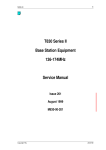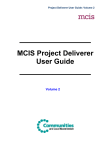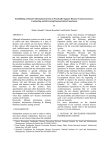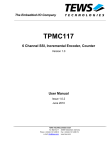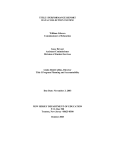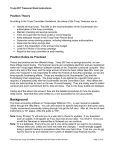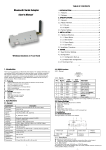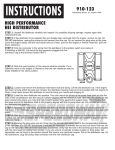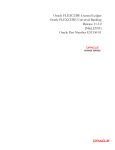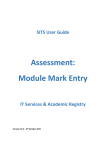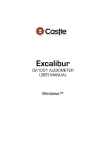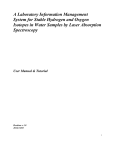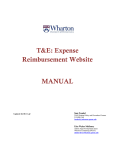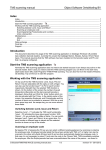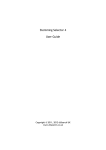Download NISAT database public user manual
Transcript
NISAT database public user manual
Introduction
The NISAT database project collects information on transfers of small arms and light
weapons from a variety of sources and compiles them in this database. The database
does not provide a definitive value for states' exports and imports.
The database therefore provides the user with an opportunity to access information
from a wide variety of open data sources. Users should take note that:
-
in many cases the NISAT database may contain more than one reference to the
same transfer (from different sources); and
-
transfers taking place in many parts of the world may well remain unreported.
Absence of information should not be regarded as evidence that transfers have
not taken place.
Even though the majority of the information comes from official government sources,
in many cases it is incomplete and only offers a partial snapshot of the global trade in
small arms and light weapons. Users should bear this in mind when discovering that
imports do not always correlate with exports (or vice versa).
Furthermore, users should be aware that customs data (Comtrade and national
customs) merely reports the flow of small arms across borders. Transfers reported by
customs sources may not record the final country of destination. Some transfers may
concern the temporary movement of small arms (such as for repair) rather than
definitive exports (or imports).
Please note that the researcher’s database is accessible only via a password. This part of
the database contains more detailed information and may contain copyright protected data
that can only be distributed to a limited set of scholarly users. If you wish to access the
researcher's database please send us a mail with your details.
Querying the database
It is very important to use the correct selection order for the first four steps (1,2,3,4).
More information about the steps is displayed below (click on the headings for more
information).
1. Reverse querying
2. Select country or region 1
3. Imports from or exports to
4. Select country or region 2
Select PRIO arms classification
Select level of detail
Select data source
Select start year
Select end year
Select vendor type
Select data scope
Display all values in US dollars
Display data in CSV format
Once the categories have been selected the 'go' button will become active. You should
press it to search the database.
You may have to wait a few minutes for very large searches to be processed. Your
browser may 'time out' if the search takes too long. In this case please search again
using more limited parameters.
For example, a search of all US exports over the period 1962-2002 will produce an
excessively large dataset. You are advised to split up the search (perhaps by looking at
data for only ten years at a time).
Interpreting the results
The database presents information in the following categories (click on them for more
information):
Weapon type
Units
Value
Licenses issued
Weight
Licenses refused
Authorisations or Deliveries
Data sources
Government or industrial sale
Accuracy
Reliability
Small arms only
Reverse querying
[back]
This is a very powerful facility that instructs the database to automatically search the
'mirror' of a particular transaction. A search for a particular country's exports will also
check all other countries' declarations of their imports. Similarly, a search for a
country's imports will also reveal exports to it by all other countries.
In this way a more complete dataset can be generated. For example, the German
Democratic Republic (DDR) did not release any information about its SALW exports.
However, it is possible to build up a partial picture of the DDR's exports as a reverse
queried search will produce a table of all countries that have declared imports from
the DDR.
Please take note that reverse querying can generate very large datasets. Therefore it is
wise to limit other parameters (such as the start and end date).
Select country 1
[back]
Use this option to select the focus of the search. You will subsequently be able to
define the flow (import or export) and the partner country or region.
Some 250 countries and territories (such as Greenland or Hong Kong) are available.
The bracketed numbers after the countries and territories refer to the Correlates of
War project's classification system.
Please click on 'include data in dependencies' if you want the search to also cover a
country's dependencies. For example, selecting this option would provide on both
Denmark and Greenland. This option will not be available if the country in question
has no dependant territories.
Imports from or exports to
[back]
Please select the relationship between the parties selected in options two and four.
Select country 2
[back]
Use this option to select the partner country or region. The countries included in this
option have been dynamically generated according to the previous selections (reverse
querying, country 1, and import/export).
The bracketed numbers after the countries and territories refer to the Correlates of
War project's classification system.
Please select 'include data on dependencies' if you want the search to also cover a
country's dependencies. For example, selecting this option would provide on both
Denmark and Greenland. This option will not be available if a particular country does
not have any dependencies.
Country Name
The database uses data reported in the various sources. Users should be aware that the
destination, or origin, reported in the sources may not be actual source or end user of
the weapons.
In some cases arms are re-exported through a number of countries. Where this is
apparent we have made a note in the database. However, in many cases the ultimate
origin and destination of weapons is not indicated.
Please note that during an upgrade of the database some country names were
amended. (for example St. Kitts & Nevis was amended to St. Kitts-Nevis). Users of
the Researchers database could use the 'Display in CSV format' which will provide
the number which uniquely identifies each country.
Special destinations:
All countries - This term is used when a source identifies the total value of its exports
of a particular weapon type. In practice, this figure is generally a sum of reported
exports to individual destinations. Users should therefore be careful to avoid overestimating countries arms exports.
However, some sources only provide aggregated figures. In such cases the 'All
countries' figure represents the extent of available information.
Unspecified country - In many cases, data sources only indicate that a transfer has
taken place, but do not list its origin or destination. This could be because the source
wishes to censor the data, or is unaware of the actual destination/origin. Furthermore,
many reports of customs data report small transfers (perhaps below 100 USD) do not
list the import/exporting state.
Regions - Some sources list exports to regions. In some cases these may be an
aggregation (similar to 'All countries' above). In other cases, the source just lists
transfers to/from a region and does not identify the individual trading partner.
Furthermore, other sources list exports to regional organisations. For example, a
transfer could be made to NATO, rather than to one of its member states.
Users are urged to look at the original data source for clarification.
Import and Export
Users should be aware that while the popular use of the terms 'import' and 'export'
imply that the weapon in question are bought or sold, this is not always the case.
Weapons may be gifted, re-exported, or transferred temporarily for purposes of repair
or demonstration etc. In particular, customs data does not show the context of a
particular transfer.
Select PRIO arms classification
[back]
The database uses information form a wide variety of sources. Unfortunately, there is
no common global standard for classifying small arms and light weapons. While this
project follows that provided in the 1997 UN panel of experts report, there exist many
other regional (OSCE, EU) global (Wassenaar) and a myriad of national definitions.
Therefore, the various data sources provide a wide variety of descriptions of small
arms and light weapons. In order to aid comparison between the various sources we
have ascribed each weapon transferred a 'PRIO weapon type'.
The PRIO classification broadly follows the 1997 UN panel of experts report:
PRIO_Weapons
Description
Code
Small Arms, Light Weapons, Ammunition, Explosives, Missiles,
100
Parts & Accessories
150
Small Arms & Light Weapons
200
Small Arms
210
Pistols & Revolvers
220
Rifles/Shotguns - Sport
230
Rifles/Shotguns - Military
240
Machine Guns - Sub & Light
250
Military Weapons
300
Light Weapons
310
Machine Guns - Heavy
320
Cannon
330
Mortars < 100mm
340
Missile & Rocket Launchers - Man Portable
350
Grenade Launchers
400
Ammunition, Explosives & Missiles
405
Ammunition - all categories
410
Small Arms and Cannon Ammunition
415
Small Arms Ammunition
420
Grenades
430
Missiles & Rockets
440
Landmines
450
Military Explosives
500
Parts & Accessories
Please note that 100 is the top level code. If used, all weapon types will be selected.
Code 250 anomalous and only refers to the customs category '930100'. In practice, it
includes both small arms and light weapons.
Users are strongly advised to start their search using the code 100, and then narrow
down their search. This is because some data sources provide only general
descriptions of the small arms in question. Therefore a potentially interesting transfer
may only be included at the higher level.
Select level of detail
[back]
This option allows the user to select country specific weapon types or PRIO weapon
types. The advantage of the former is that they are as close as possible to what was
reported by the country or organization in question. However, that are not very
comparable. As noted above, the PRIO weapon types are comparable (but of course
lack the specificity of the country specific types).
Select start and end dates
[back]
Please use these options to define the start and end dates for your search. The dates
available are dynamically calculated based upon your previous selections in options 14.
Selecting long time periods (over several decades) may well produce excessively
large datasets.
Select vendor type
[back]
You can select whether to view information on government sales, sales by
commercial companies, or both.
Note that commercial sales will normally require an export license.
Many data sources do not specify the vendor and are coded in the database as ‘not
known’. Users should use the 'all' option to include them.
Data Scope
[back]
This option allows the user to define whether to search for:
- export license authorisations and deliveries;
- export license refusals; or
- both.
For more information on license authorisations, refusals, and deliveries please consult
the following sections.
Authorisations / licenses Issued
This column states the number of export licenses that have been issued (according to
the source).
Please note that in many cases small arms may not be delivered even after an export
license has been granted (because of cancelled contracts etc).
For more information see the note on authorisations and deliveries, below.
Licenses Refused
This column shows the number of export licenses that were refused (according to the
source).
For more information on the distinction between licenses and deliveries, see below.
Authorisation or Delivery
This column states whether the source reported an authorisation or a delivery of
SALW. The distinction between the two is:
authorisations: refer to export licenses that have been granted by the relevant
government department. Information on authorisations just refers to permission to
export. It does not guarantee that the arms were actually delivered.
deliveries: refer to actual shipments of SALW that have arrived at the stated
destination. Similarly, the existence of a delivery does not guarantee that an
authorisation has been granted.
In practice the value of goods delivered are often less than those licensed for export.
This can be because deals may be cancelled or reduced, or an exporter may request a
license for a potential transaction which is not fulfilled.
Moreover, care should be exercised when comparing authorisations and deliveries
(from different data sources). In some cases there may be a considerable delay
between the authorisation and delivery (for example some UK licenses are valid for
two years).
Furthermore, users should be aware that some transactions may be 'double counted' in
the database. This may occur if two or more different sources provide information on
the authorisation and delivery respectively.
Display all values in US Dollars
[back]
All the transfers in the database are stored in the currency in which they were reported
(euros, pounds, dollars etc). To aid comparison, this facility converts all the local
currencies into US dollars.
The conversion rate is calculated using the average for the year in question, which has
been supplied by Oanda.
Please note that all figures in the database are presented in current USD, and users
will have to adjust them for USD inflation if necessary.
Export data in CSV format
[back]
This option produces output from the database in Comma Separated Variable (CSV)
format. CSV formatted data can easily be imported into spreadsheet or data analysis
programmes (such as Excel or SPSS).
Units
[back]
This column states the number of units of SALW transferred (as stated by the source).
Value
[back]
This column states the value of the SALW transfer (as stated by the source). The
value figure is that which was stated in the source.
Please note that if you have selected to display all values in US dollars, this figure will
have been recalculated using the average exchange rate of the year in question. The
exchange rates were obtained from www.oanda.com .
Licenses Issued
[back]
This column states the number of export licenses that have been issued (according to
the source).
Please note that in many cases small arms may not be delivered even after an export
license has been granted (because of cancelled contracts etc).
For more information see the note on authorisations and deliveries.
Weight
[back]
This column states the weight of the goods being transferred. Except where stated,
this figure is in kilograms (kg).
Licenses Refused
[back]
This column shows the number of export licenses that were refused (according to the
source).
For more information on the distinction between licenses and deliveries, please refer
to the following section.
Authorisation or Delivery
[back]
This column states whether the source reported an authorisation or a delivery of
SALW. The distinction between the two is:
authorisations: refer to export licenses that have been granted by the relevant
government department. Information on authorisations just refers to
permission to export. It does not guarantee that the arms were actually
delivered.
deliveries: refer to actual shipments of SALW that have arrived at the stated
destination. Similarly, the existence of a delivery does not guarantee that an
authorisation has been granted.
In practice the value of goods delivered are often less than those licensed for export.
This can be because deals may be cancelled or reduced, or an exporter may request a
license for a potential transaction which is not fulfilled.
Moreover, care should be exercised when comparing authorisations and deliveries
(from different data sources). In some cases there may be a considerable delay
between the authorisation and delivery (for example some UK licenses are valid for
two years).
Furthermore, users should be aware that some transactions may be 'double counted' in
the database. This may occur if two or more different sources provide information on
the authorisation and delivery respectively.
Data sources
[back]
For more information on the various data sources used in the NISAT database please
consult:
Haug, M et al. (2002) Shining a Light on Small Arms Exports: The
Record of State Transparency Small Arms Survey. p 70
Database users should also consult the pages on annual arms export reports, and
customs data, which are available on the menu to the left.
Notes on selected data sources
Users should be aware that the various sources use differing methodologies and
weapons categories. Moreover, some countries have changed their reporting
methodologies over the years. Users are advised to check the original source of the
information.
In weapon type names, '&/' is used to indicate 'and /or'. This has been used to save
characters and provide more space for the weapon type description.
Belgium
Belgium did not publish specific information on exports of small arms by country of
destination for the years 2000 or 2002 (but did for 1999 and 2001).
Bulgaria
Bulgaria's Annual Report for 2002-2003 is an unofficial translation.
The Annual Report 2002-2003 does not disaggregate exports by country and weapons
type. However, it does include percentages of total exports separated into categories
corresponding with the EU Code <LINK> of Conduct's common list of military
equipment (June 2000). We have calculated the value of Bulgaria's exports from the
categories that include SALW: 'CO1', 'CO2', 'CO3' and 'CO4' (see the Annual Report
for definitions). The export values (destination listed as 'All countries') represent
Bulgaria's total yearly exports divided by the percentages for each weapons category
and therefore the accuracy of the export values is listed as 'low'.
Canada
Exports to the United States are omitted from the annual reports, as an export permit
is not required in Canada for shipments to the United States.
Czech Republic
The Czech Republic's 2003 Annual Report is more comprehensive than those
published in previous years. The report includes overviews of imports and exports in
selected small arms and light weapons categories, providing a sum of imports and
exports and their country sources and destinations, although the quantities are not
disaggregated by individual country. Therefore users will find entries under the code
'All countries' for the total amounts of each SALW category, as well as under
individual country codes for each SALW category. In the latter instance the quantities
are unknown.
Finland
In the annual report, ‘Cartridge cases’, ‘Bullets’, ‘Fuses and Accessories’, ‘Base bleed
unit components’, 'Percussion primers' and 'Tracers' are all included as ‘Ammunition
Components’. But for 2002 'Rifle cartridges/bullets' are included as 'Rifle cartridges'.
Thus bullets are included as components for years up to and including 2001, but
included as cartridges for 2002. Figures given for export value are rounded to the
nearest 100 FIM for 2000, to the nearest 100 EUR for 2001 and are accurate to the
EUR for 2002.
Finnish legislation distinguishes between exports (to non-EU countries) and transfers
(to EU partners). Obtaining a commercial transfer licence is significantly easier than
obtaining a commercial export licence, something which is reflected in the relative
number of export licences issued (59) vs. transfer licences (547) for the year 2000.
See Finnish annual report 2000 for further details.
Germany
The German annual report presents different information for different categories of
importing states. For EU and NATO members, and 'states on an equal footing', the
report only states the total value of licences issued, and whether licences for particular
categories were issued. No information is provided on licences refused (though such
refusals would be unlikely).
'Other countries' are reported in much greater detail. However, the information is not
comprehensive. In general, information on the largest transfers to a given country is
provided via more detailed description, and the value of the transfer is reported as a
percentage of the total transfers to that country.
Concerning 'Other countries' the report states both the number of licences refused,
together with the total value of these refusals, and those licence denials which were
reported under the EU Code <LINK> of Conduct. The two do not necessarily refer to
the same licence applications. This is for two reasons, first, there is a delay in
reporting under the EU code, so some of the licences listed in this category may have
been refused (and reported) during the previous year. Second, the denials reported
under the EU Code include exporters that were rebuffed following an initial enquiry
into whether a licence application was likely to succeed. The list of licence refusals
does not include this information on initial enquiries.
In many cases the German annual report has listed transfers of a group of weapon
types (rather than a single category). Where possible we have provided a verbatim
translation of the annual report entry. However, in many cases this has not been
possible due to the names of these weapons. Therefore the weapon type name has
been abridged. In those cases an asterisk (*) has been added to the end of the weapon
type. Users are urged to consult the German Annual Report in these cases.
Furthermore, for similar reasons, in some cases we have provided a generic weapon
type (such as 'ammunition') and provided more detail in a text note.
For more information see the note on weapon types.
Netherlands
Licences for temporary export have been disregarded in the Netherlands' reports, in
view of the fact that such licences are subject to mandatory re-import. See the
Netherlands arms export policy in 2003 for further details.
In the Netherlands annual report 2003 arms exports are reported for the first-half and
second-half of the year. Users of the database will therefore find two entries for the
same weapons categories for certain countries, corresponding to the separate licences
issued by the Dutch Central Import and Export Service.
Norway
Values are rounded to the nearest 1000 NOK. ‘Våpenholdere’ ('weaponholders' and
'stands') and ‘stativer’ ('weaponholders' and 'stands') are included as 'parts and
components'. ‘Skiskytterrifle’ & ‘jaktrifle’ ('ski-shooting rifle' & 'hunting rifle') are
included as 'rifles and components'. ‘Ammunition and Explosives’ includes
Ammunition components and blanks. ‘Explosives’ includes Explosive components
(‘utgangsmateriale’). ‘Missiles, bombs, torpedoes & grenades’ includes components
thereof. ‘Silencers’ are included as rifles and components. '57 mm øvingspatron' is not
included in the database because it is likely not to be a small arm or light weapon.
Norwegian export reports divide exported arms into two categories. Category A
contains arms and ammunition in addition to material of significant military value.
Category B includes all other military equipment.
Since 2005 Norwegian export reports contain separate tables for 'Exports of handguns
and their components.'
Sweden
Values for exports to all countries 2002 to the nearest million SEK, ‘0’ value given
for total exports of Assault Rifles and parts in 2001 and 2002 presumably indicates a
value of <500 000 SEK
United Kingdom
Concerning information from the UK annual report:
SIELs are Standard Individual Export Licences, OIELs are Open Individual
Export Licences, SITLs are Standard Individual Transit Licences, see UK
Annual Reports for more details. Up to and including year 2000, the Open
Individual Export Licences are not differentiated between Temporary and
Permanent exports.
Singular/Plural distinctions are ignored
The very large number of weapon types contained in the UK annual report has
necessitated some conflation of the arms categories (see the section on weapon types).
Furthermore, for similar reasons, in some cases we have provided a generic weapon
type (such as 'ammunition') and provided more detail in a text note.
Instances of conflation are:
‘Machine Pistols’ are included as Sub-Machine Guns.
‘Pistols’, ‘Semi-automatic Pistols’ and ‘Revolvers’ are included as 'Pistols &/
Revolvers'.
‘Sporting Rifles’, ‘Sporting Guns’ and ‘Combination Rifle/Shotguns’ are
included as ‘Sporting Rifles &/ Sporting Guns &/ Sporting Shotguns’.
‘Heavy Machine Guns’ and ‘General Purpose Machine Guns’ are included as
‘Machine Guns’.
'Smoke Hand Grenades', 'Devices Containing Military Pyrotechnic Materials'
and 'Smoke Ammunition' are all included as 'Military Pyrotechnics &/
Associated Ammunition/Equipment'
'Grenades' and 'Hand Grenades' both cover 'Fragmentation Hand Grenades'
and have been used interchangeably
'CS Hand Grenades', 'Stun Grenades' and 'Thunderflashes' are all included as
'Thunderflashes &/ Stun Grenades &/ CS Grenades'
‘Target Pistols’ and ‘Sporting Pistols’ are included as ‘Sporting Pistols’
(before 2001, this is specified as a text note and categorised as ‘Pistols &
Revolvers’)
Irritant ammunition has either been included in 'Crowd Control &/ Irritant
Ammunition' or 'Tear Gas/Irritant Ammunition'. This is due to changes in UK
reporting practices.
United States
The US annual report on its arms exports is known as the '655 Report'. This comprises
two reports:
- a State Department report on export licence authorisations; and
- a two-part Pentagon report on actual deliveries as part of the 'Excess Defense
Articles' (EDA) programme or as 'Foreign Military Sales' (FMS).
Direct Commercial Sales Authorisations (DCSA) reported by the State Department
are listed as authorisations for industrial vendors. FMS are listed as deliveries by
government vendors. EDA are classified as: offered (status code 6); accepted (7);
rejected (8); delivered (9). For FY 2003, all figures are status code 6, which we list as
'authorisations'.
In the case of EDA, We used the "allocation" field as the quantity offered and "current
value notified" field for the dollar value of the equipment concerned (even though
many of these items will in fact be given away).
US Annual Reports use fiscals years (FY) running from 1 October to 30 September.
Thus the US Annual Report data for FY2000 is listed in the database as 1999-2000
For fiscal years up to and including 1999, FMS figures (which are rounded to the
nearest 1000 USD) are reported as being of high accuracy. After 1999, figures are
reported as being of medium accuracy.
The DCSA Annual Report FY2004 distinguishes between between authorisations of
defence articles and those associated with defence services. Only the authorisations of
defence articles are included in the database.
Concerning individual weapon categories, the following distinctions have been made:
Some weapon definitions have been included in broader categories. For
instance, 9mm Ball Ammunition is included as '.22 thru .50 cartridges'. In
these cases a text note is added.
‘non-specific missile parts’ are included (as non-small arms only) as ‘missiles’
can include man-portable missiles. This category may well include parts for
large calibre systems.
‘.22 thru .50 cartridges’ are considered small arms only.
20mm-40mm ammunition is included as 'non-small arms only'.
Ammunition over 100mm calibre are not included (as the 1997 UN panel of
experts definition of small arms and light weapon includes mortars of up to
100mm).
‘rockets’ were not included.
‘mortars’ and ‘mortar rounds’ included as 'non-small arms only' as the calibre
is unknown (see above).
The category ‘37-75mm cartridges’ is used in the Defense Department EDA
report, whereas ’40-75mm cartridges’ is used in the State Department FMS
report. We used the category ‘37/40mm-75mm cartridges’ category to cover
both. Although the FMS report FY 2003 uses the category '37-75mm
cartridges', the generic '37/40mm-75 cartridges' category is still applied.
Entries under the category 'weapons' spares' in FMS are not included.
The category 'Pol, Gases and Fuels' is used in the DCSA FMS FY2003 report
and is included as 'Riot control chemicals (anti-pers)' (non-small arms only).
Government or Industrial sale
[back]
This column shows the identity of the vendor. This is currently defined in three ways:
government: sales by government ministries of their SALW (for example the
sale of surplus equipment by a ministry of defence).
industrial: commercial sales of SALW negotiated by companies. Please note
that these will normally also have to receive a government export license.
not known: instances where no information is available.
Please see the notes on the individual data sources for more specific information.
Accuracy
[back]
We provide an assessment of the accuracy of figures reported by the sources. This is
not an indication of the reliability of the source. Instead it is a consequence of many
figures being reported by sources are rounded or are approximations.
The accuracy column contains one of three words 'low', 'medium' and 'high'. These are
defined as:
low: the source supplied estimates accurate to, and figures rounded to, more
than the nearest USD 1000 (for example, a report that a country had exported
USD 1.2 million worth of ammunition);
medium: the source supplied estimates accurate to, and figures rounded to,
USD 1000 or less (for example, a report that a country exported $59 000 worth
of small arms).
In addition, all instances in which the person responsible for data entry has
calculated a figure are defined as 'medium'. For example, if small arms were
defined as comprising 56.879% of a country's total arms exports of USD 200
000, then we would calculate the figure as being USD 113 758. As the figure
had not been directly supplied by the source, it's accuracy would be described
as being 'medium'.
high: the source supplied figures with no evident estimation, rounding or
calculation.
Please note that an assessment of the reliability of the source is provided in a different
column (reliability, outlined in the following section). It is possible for a reliable
source to provide an inaccurate figure (for example, a government report might state
that approximately USD 500 000 worth of small arms were exported during a
particular year).
Reliability
[back]
We provide a description of the source and a subjective judgment concerning its
reliability. These are each defined by two categorisations. Concerning the description
of the source, they are:
Primary: original documents produced by the party involved in the transfer (such as a
government report on its arms exports); and eye witness reports.
Secondary: information reported by a third party (such as a press report).
Concerning the reliability of the source, this is divided into two categorisations - high
and less. This is based on a subjective judgment by the person responsible for entering
the data. In general it is based upon an assessment of the veracity of the information
provided by the source which is based upon our assessment of whether the source has
systems in place to check data and ensure data quality.
Please note that an evaluation of the accuracy of the figure provided by the source is
provided in a different column (accuracy). It is possible for a reliable source to
provide an inaccurate figure (for example, a government report might state that
approximately USD 500 000 worth of small arms were exported during a particular
year).
Small Arms Only
[back]
Some transfers comprise equipment that is entirely covered by the 1997 UN panel of
experts definition of small arms and light weapons. In such cases the column includes
'yes'.
In other cases the column includes 'no'. This occurs in two cases:
- if the material includes both SALW and other equipment (for example, if a
transaction were for 'machineguns and howitzers'); or
- if the description of the material does not specify whether it covers SALW or
not (for example, reports of transfers of 'ammunition').


















